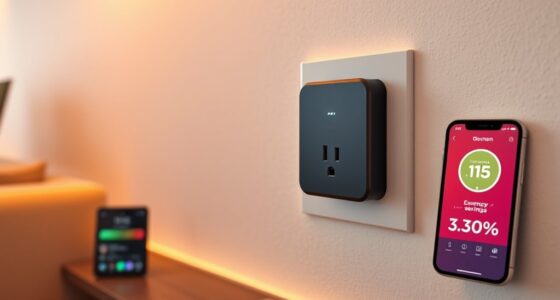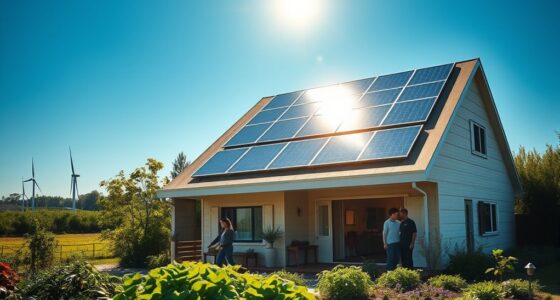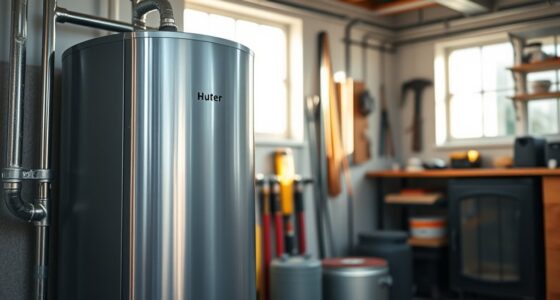Ceiling fan blade direction affects your comfort throughout the year. In summer, set your fan to spin counterclockwise to create a cooling downdraft that makes you feel cooler without lowering the room temperature. During winter, switch to clockwise to help distribute warm air evenly. Correct fan operation can reduce energy costs and improve comfort. Keep exploring to discover tips on adjusting your fan properly and maximizing its benefits year-round.
Key Takeaways
- Proper fan blade direction in summer creates a wind-chill effect, enhancing cooling and comfort without lowering room temperature.
- In winter, clockwise rotation helps distribute warm air evenly, making rooms feel warmer and more comfortable.
- Correct blade direction optimizes energy efficiency by reducing reliance on heating or cooling systems.
- Adjusting fan direction seasonally ensures maximum airflow benefits, improving overall comfort.
- Regularly checking and maintaining fan blade direction prevents drafts and maintains quiet, effective operation.
How Fan Direction Influences Seasonal Comfort
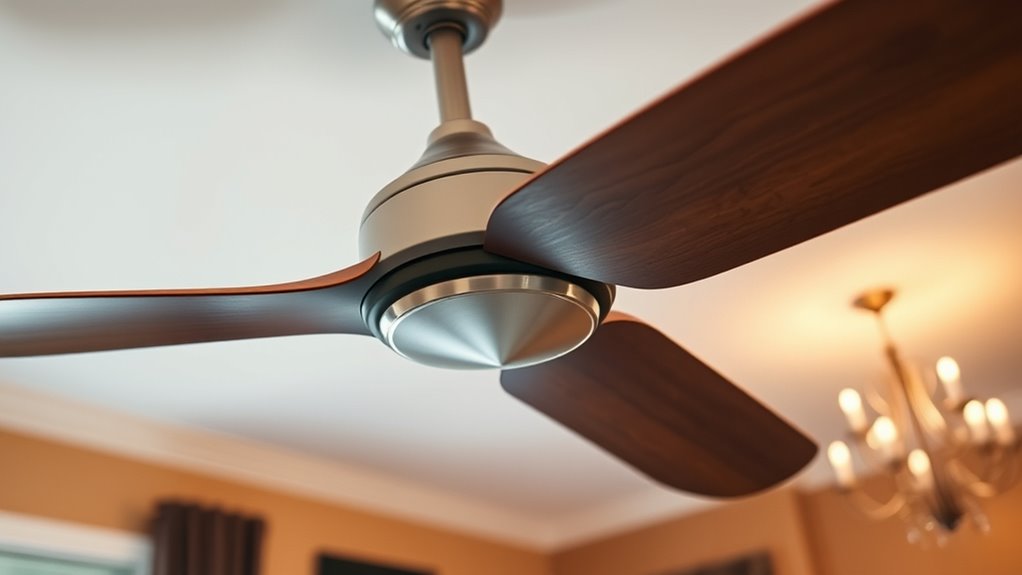
Have you ever wondered how the direction of your ceiling fan affects your comfort throughout the year? When you set your fan to rotate counterclockwise in summer, it creates a downdraft that pushes air downward, producing a wind-chill effect. This breeze helps evaporate sweat and cools you without lowering the room temperature, allowing you to raise the thermostat by about 4°F. Using higher fan speeds enhances this cooling sensation, making hot days more bearable. Remember, ceiling fans cool people, not rooms, so turn them off when you leave to save energy. Proper seasonal adjustment of fan direction reduces reliance on air conditioning, lowering your energy bills. Additionally, understanding the fan blade direction can help you optimize comfort and energy efficiency throughout the year. It’s a simple yet effective way to improve comfort and efficiency year-round.
The Role of Blade Rotation in Cooling Efficiency
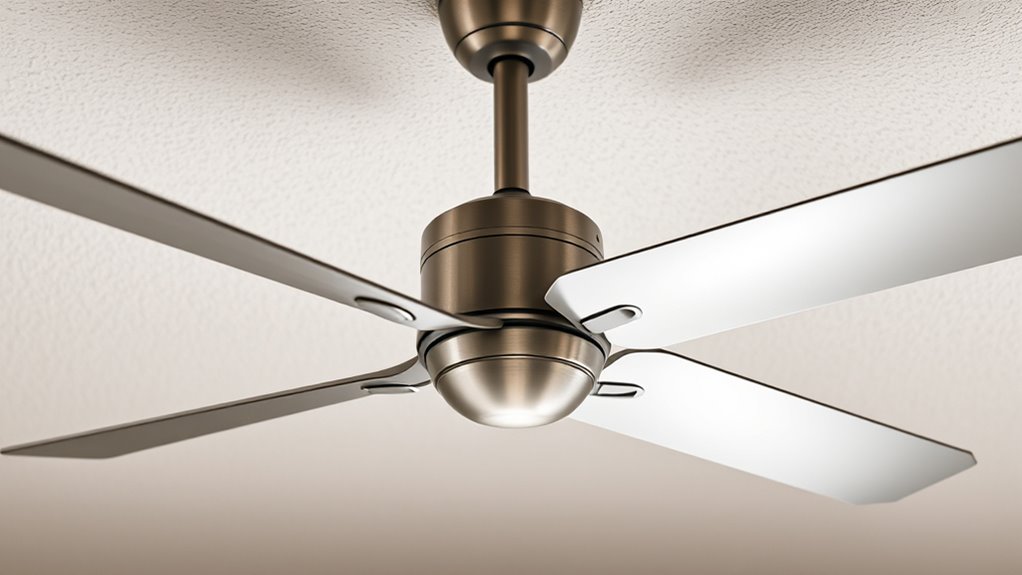
The direction in which your ceiling fan blades rotate plays a crucial role in maximizing cooling efficiency. When blades turn counterclockwise, they create a downdraft that produces an invigorating breeze, making you feel cooler. This airflow circulates air more effectively, allowing your air conditioning to work less and enabling you to raise the thermostat by about 4°F without sacrificing comfort. The wind-chill effect from this rotation increases your perceived cooling, reducing energy costs by saving up to 7.2% on cooling expenses. Additionally, the air velocity generated—between 200 and 700 feet per minute—enhances comfort, especially when combined with proper air circulation. Proper blade rotation ensures you get the most out of your ceiling fan’s cooling benefits, saving energy and boosting comfort. High airflow rates contribute significantly to achieving optimal cooling performance.
Optimizing Heating With Proper Fan Rotation
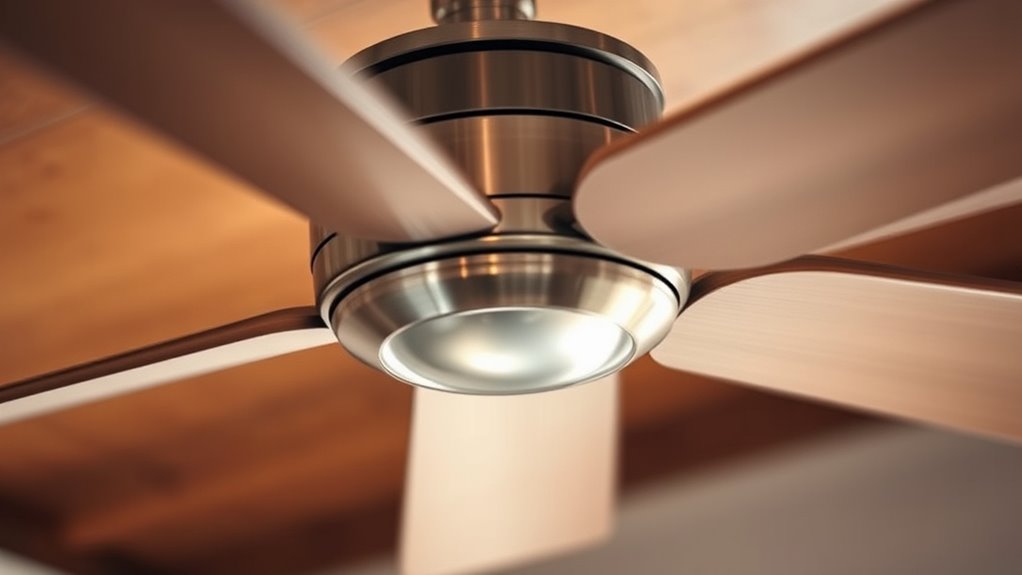
Switching your ceiling fan to rotate clockwise during winter is a simple, cost-free way to improve heating efficiency. This rotation pulls cool air upward and pushes warm air down from the ceiling, helping to mix air layers and prevent warm air from lingering near the ceiling. As a result, the room feels more evenly heated, reducing cold spots and making warmth more accessible at occupant level. Keep the fan at a low speed to avoid creating a draft, and ensure the blades have a gentle pitch for effective circulation. This setup allows your existing heat sources, like radiators or fireplaces, to distribute warmth more effectively. It can help you set the thermostat lower without sacrificing comfort, ultimately making your space cozier and more energy-efficient during winter. Proper fan rotation maximizes heat distribution and can lead to noticeable savings on energy bills. Additionally, understanding ceiling fan blade direction can help you optimize your heating strategy year-round.
Energy Savings Through Correct Fan Operation

Using your ceiling fan correctly can considerably lower your cooling costs by allowing you to raise your thermostat settings without sacrificing comfort. When fans push air downward in summer, they create a wind chill effect that makes you feel cooler, reducing the need for air conditioning. Proper operation also helps cut heating expenses in winter by encouraging efficient airflow and temperature distribution. Studies show that the direction of fan blades plays a crucial role in achieving these energy savings. Additionally, understanding remote work principles such as optimizing your workspace can enhance overall comfort and productivity at home.
Lower Cooling Costs
Adjusting your ceiling fan’s blade direction seasonally can considerably lower cooling costs. During warm months, setting the fan to rotate counterclockwise pushes air downward, creating a breeze that makes you feel cooler through the wind-chill effect. This allows you to raise your thermostat by up to 4°F without sacrificing comfort, reducing reliance on your air conditioner. Ceiling fans use only about 50 to 60 watts, costing roughly $0.05 per day to run, compared to the $4 daily cost of running an air conditioner. By maximizing fan efficiency and using it alongside your AC, you can cut overall cooling energy use by 3-5% for each degree you raise your thermostat. Proper blade direction helps you save money while staying comfortable during hot weather. Reversing fan blades not only improves heating efficiency in winter but also enhances overall energy savings throughout the year. Additionally, understanding energy-efficient fan operation can further optimize your utility bills and comfort levels.
Reduced Heating Expenses
Properly operating your ceiling fan in winter can considerably reduce heating expenses by redistributing warm air trapped near the ceiling into the living space. When you run your fan clockwise at low speed, it pushes the warm air downward, improving heat distribution. This means you can lower your thermostat without sacrificing comfort, cutting your heating bills by up to 15%. Since fans use about 50 watts compared to central heating’s 3,500 watts, they’re a highly energy-efficient way to boost warmth. Ceiling fans can alter perceived room temperature by about 4°F, which enhances the effectiveness of using the fan to improve heat circulation. Additionally, understanding air circulation patterns can help optimize fan placement and operation for maximum comfort and savings. Use the table below to understand how fan operation affects savings:
| Fan Operation | Effect on Heating Costs |
|---|---|
| Clockwise in winter | Improves heat circulation, reduces bills |
| Counterclockwise | Disperses cool air, increases heating needs |
| Low speed | Ensures gentle redistribution |
| High speed | May cause drafts and discomfort |
Proper use maximizes energy savings and comfort.
How to Identify and Adjust Fan Blade Direction
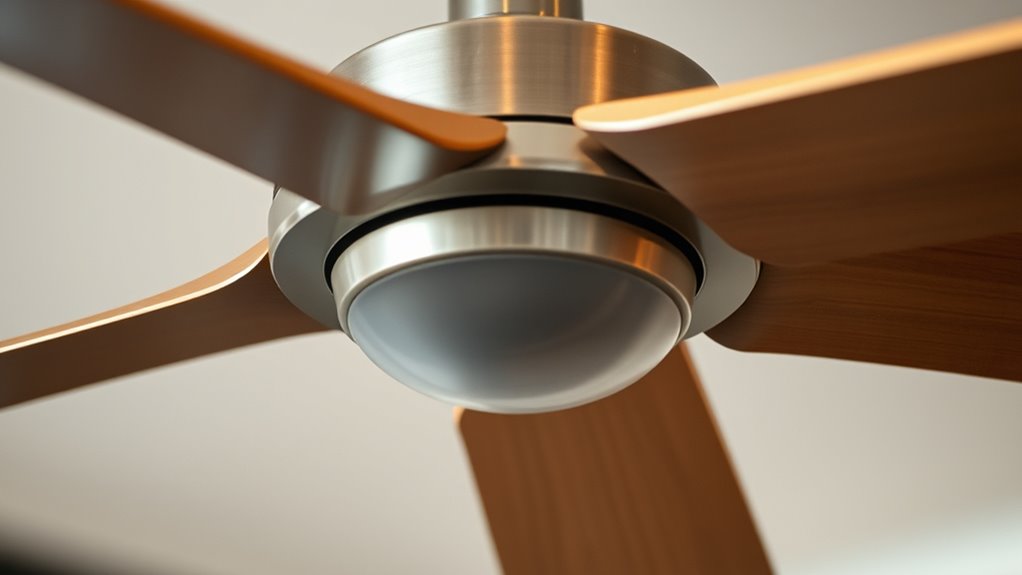
Ever wonder how to tell if your ceiling fan is spinning in the right direction? Stand under the fan and observe the blades. If they move from right to left, it’s spinning counterclockwise, which is ideal for summer cooling. To check without feeling the breeze, look for a visual cue—most fans have a small switch on the motor housing. Flip this switch to change direction. If your fan has a remote control, press the “reverse” button; some fans even have a hanging cord or wall control to make adjustments. Always turn off the fan before switching directions for safety. Proper identification and adjustment ensure you maximize comfort and energy efficiency throughout the seasons. Additionally, understanding fan blade direction can help you optimize airflow for different weather conditions.
Common Mistakes and Best Practices for Fan Use
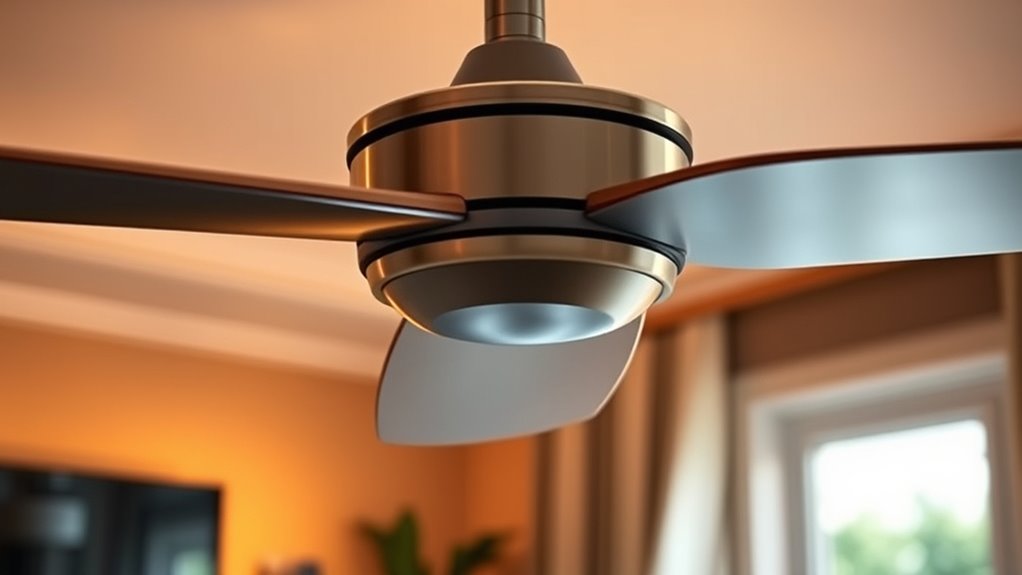
Many common mistakes can reduce the effectiveness of your ceiling fan and increase energy bills. Running fans in unoccupied rooms wastes energy without providing comfort. Not adjusting your thermostat when using fans can lead to up to 15% higher cooling costs. Remember, fans cool people, not rooms, by creating wind chill, so misusing them can be inefficient. Overusing fans at high speeds in small spaces may cause drafts and discomfort. Failing to switch blade direction seasonally diminishes their efficiency. Skipping regular maintenance, like cleaning blades and tightening screws, can impair performance and cause noise. To maximize efficiency, turn off fans when rooms are empty, adjust thermostat settings appropriately, and select the right speed for the space. Proper use and maintenance ensure comfort and energy savings. Choosing energy-efficient models can further reduce electricity consumption and enhance overall performance.
Frequently Asked Questions
Can Changing Fan Direction Harm the Fan’s Motor or Blades?
Changing fan direction won’t harm your motor or blades if you follow proper steps. Always turn off the power before reversing, let the blades stop completely, and use the correct switch to avoid mechanical or electrical stress. Regularly inspect and tighten blades to prevent wobbling. Proper handling and maintenance guarantee your fan operates smoothly, preventing damage and extending its lifespan when you switch directions seasonally.
Does Fan Blade Size Affect the Efficiency of Airflow and Comfort?
You’re wondering if blade size impacts airflow efficiency and comfort. Larger blades, like 1.4 meters, spread air more evenly and cover bigger spaces, making them more energy-efficient for larger rooms. Smaller blades tend to focus airflow locally. Choosing the right size depends on your room’s size and your comfort needs. Bigger blades generally improve airflow coverage and comfort, especially in larger areas, with less turbulence and more uniform air distribution.
How Often Should I Switch Fan Direction Seasonally for Optimal Comfort?
Imagine your fan as a seasonal helper, adjusting to keep you comfortable year-round. You should switch its direction twice a year—once in spring and once in fall—so it aligns with the changing temperatures. In summer, set it counterclockwise for a cooling breeze. In winter, switch it to clockwise to gently circulate warm air. These simple changes save energy, boost comfort, and support your heating and cooling systems efficiently.
Are There Specific Fan Models Better Suited for Seasonal Direction Changes?
You’ll find that some fan models are better suited for seasonal direction changes. Look for fans with reversible motors, easy-to-access switches, and smart controls, as these make switching effortless. High-quality fans with adjustable blade pitch and durable motors handle frequent changes without issues. Choosing models with clear instructions and remote controls guarantees you can switch directions smoothly, maximizing comfort and energy efficiency year-round.
Can Improper Fan Use Increase Indoor Humidity or Affect Air Quality?
Imagine your indoor air as a delicate dance—improper fan use can throw off the rhythm. When your fan pushes warm, humid air downward in summer, it traps moisture at eye level, making you feel muggy and uncomfortable. Poor circulation also allows pollutants and dust to settle, worsening air quality. Correctly reversing fan direction helps maintain fresh airflow, reduces humidity, and keeps your home feeling just-right.
Conclusion
So, next time you flip that switch, remember: your fan’s blade direction isn’t just a detail, it’s the secret to your comfort—or chaos. Ignore it, and you might as well be calculating your energy bills with a crystal ball. Get it right, and you’ll stay cozy, save money, and maybe even impress your friends with your fan mastery. Because, honestly, who knew that such a tiny twist could make such a huge difference?
I’m Theodore, and I love tiny houses. In fact, I’m the author of Tiny House 43, a book about tiny houses that are also tree houses. I think they’re magical places where imaginations can run wild and adventures are just waiting to happen.
While tree houses are often associated with childhood, they can be the perfect adult retreat. They offer a cozy space to relax and unwind, surrounded by nature. And since they’re typically built on stilts or raised platforms, they offer stunning views that traditional homes simply can’t match.
If you’re looking for a unique and romantic getaway, a tree house tiny house might just be the perfect option.




